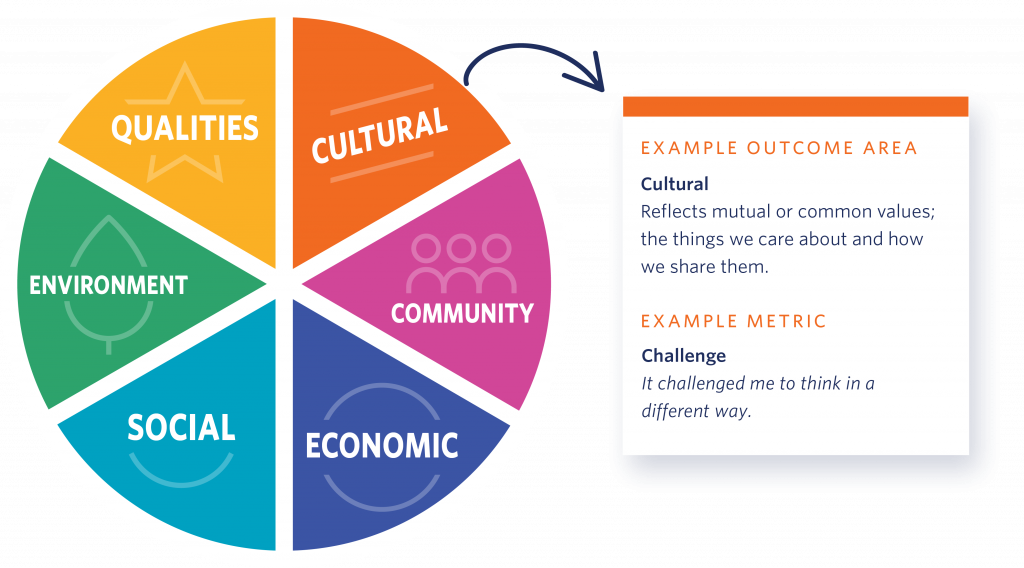In September, we launched a revised Outcomes Framework, designed to simplify and clarify our dimensions terminology and make selecting the right measures easier for Culture Counts users.
Our Outcomes Framework has been updated to reflect a more clear and meaningful grouping of concepts, and take into account user feedback, accessibility and language research. This new framework (otherwise known as an schema) seeks to simplify the evaluation concepts in the Culture Counts Evaluation Platform and harmonise the various pieces of research that have contributed to the way we suggest measuring outcomes and impact.

Dimensions will be categorised into one of six categories:
- Cultural: Encourages appreciation and engagement with new and diverse cultural experiences, expanding knowledge and insight, and stimulating creativity.
- Social: Improves personal and social wellbeing to support healthy, safe, and inclusive communities.
- Community: Strengthens ties between communities and their places.
- Economic: Promotes dynamic and resilient local economies that are required to sustain vibrant communities.
- Environment: Increases awareness of environmental issues and connection to the natural world.
- Qualities: Subjective assessments about the experience, content or perception of an artwork or performance; or the quality of the facilitation of a participatory process. These are the qualities of a work that may enable other outcomes.
What is a framework?
The Culture Counts Outcomes Framework is a way of grouping our dimensions together to help people understand how the measures sit within a broader context, how they relate to each other, and the higher level concepts that they contribute to.
The framework is like a map: if you are asked to find your house on a world map, you first look at the broadest scale, the country, then the city, then your local landmarks, and finally your house. The framework serves a similar purpose, offering easy to navigate landmarks so you can find the measures that are most relevant to you.
Key changes
The update to the framework, along with the new Dimension Selector feature, will make it much easier to view and understand how dimensions sit within the framework, as well as the definitions and meanings of outcome areas and domains.
The main changes to note are:
- The renaming of the Civic domain to the Community domain. This change better reflects the outcomes measured within the domain, including community belonging, participation and engagement in the community, and feelings of pride for the community and place.
- The movement of place-based dimensions such as ‘It made me feel proud of my local area’ from the Environmental domain to the Community domain.
- The renaming of the Arts Quality domain to the Qualities domain. This name change reflects the fact that dimensions are measuring many different attributes and qualities that make up an event or participatory experience, not whether it was good or bad.
- The movement of some dimensions from Outcome domains to the Qualities domain. This change is to reinforce the distinction between dimensions that are about a change in the individual (outcomes) and those that are an opinion or perspective about the work (qualities).
- There are also minor changes to outcome area names to ensure that they more accurately and comprehensively describe the outcome in question. Outcome area names and descriptions can now be found in the platform to help you choose the outcomes that best align with your objectives.
The wording of dimension statements is not affected by these changes, and there is no impact to existing surveys or previous dimension data that clients have collected. Please contact your Client Manager if you have difficulty locating dimensions in the survey builder, or have questions about your organisation’s strategic alignment.
Next steps
Along with this update to the framework and launch of the new dimension selector, the Culture Counts team is undertaking ongoing research and development into the dimension set, inclusions, terminology and geographical differences. This reflects our continuous consultation with clients, the evolution of language, our commitment to meeting the changing needs of the sectors we work with, and our recognition of the benefits of consistent measurement. We welcome your thoughts and feedback.







